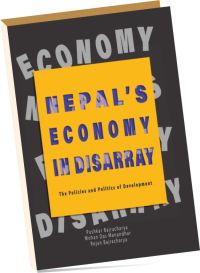 Nepal remains a least developed economy despite adopting liberal economic policies. Poverty reduction and economic growth remain the cornerstones of the country’s development agenda since the 1950s. The country aims to shed the image of a least developed country to a middle-income country by 2023. However, the path to becoming a middle-income economy is fraught with challenges.
Nepal remains a least developed economy despite adopting liberal economic policies. Poverty reduction and economic growth remain the cornerstones of the country’s development agenda since the 1950s. The country aims to shed the image of a least developed country to a middle-income country by 2023. However, the path to becoming a middle-income economy is fraught with challenges.
A new book authored jointly by three well-known policy analysts tries to uncover the reasons why Nepal has remained a basket case of low economic growth. The book “Nepal’s Economy in Disarray: The Policies and Politics of Development” attempts to dissect the issue of economic growth from a political-economic perspective. The authors have adopted a historical and institutional framework to analyse the effect of economic growth. A broader political and institutional context of Nepal’s economic growth sets the context for analysis. The focus of the book on the interplay of how political and institutional regimes overlap with the economic policies distinguishes it from other works on the same issue. As the authors argue, Nepal’s economy, along with social order is at a crossroads. The share of the agriculture sector has fallen to about a quarter of the country’s gross domestic product (GDP). However, the decrease is not compensated by an increase in the manufacturing sector. But the rise of the tertiary sector dominated by banking, finance and trading has taken place vacated by a decline in the agriculture sector. The example of the South-East Asian economic miracle shows that economies that develop rapidly take the root of industrialisation and diversify into services and even their countries achieve status of developed economies. However, Nepal has entered the period of de-industrialisation before it could industrialise. This has been one the pitfalls of the liberalisation adopted in the 1990s.
Despite being a least developed economy, labour cost in Nepal is higher than in India and is non-skilled. The export of labour services has a short-term benefit but negatively impacts the long term growth. Increased labour service export has not allowed Nepal to benefit from the pool of active and low-cost labour for its industrialisation. From the purist economic perspective, the export of labour services has positive impacts in terms of remittance inflow and provides a lifeline to the country’s Balance of Payment (BoP). The issue of how Nepal weans itself from a more natural path of labour export to developing a suitable foundation for economic growth is a significant challenge at the moment.
The book rightly acknowledges Nepal’s poverty as having both socio-political and economic dimensions. Hence, any prudent public policy in Nepal has to balance both these realities. The exclusion of a large section of the population is as detrimental to sustained economic growth as economic policies that have been introduced in a piecemeal basis. On the social empowerment front, Nepal has made notable progress in social and human development indicators. The primary school enrollment and gender parity in school education, life expectancy, child mortality, immunisation of children and the decrease in the prevalence of non-communicable disease are some the noteworthy advancements. The social and political empowerment of women, dalits, madeshis and other marginalised members of the society has taken centre-stage with the promulgation of the Federal Constitution in 2015.
However, the real economic growth which is necessary to sustain the progress made in the social and political empowerment is far from satisfactory. In terms of economic policies, Nepal has swung between the extremes of the state-controlled growth during the Panchayat period and unbridled liberalisation and privatisation after the political change in 1990. The cooperative has been inducted as the third pillar of the economy by the new constitution. The economic liberalisation and economic growth post-1990 have their benefits and pitfalls. The segments of the economy expanded dramatically with private sector investment due to economic liberalisation. However, unbridled liberalisation, weak enforcement capacity of the state and lack of social protection has exacerbated income inequality.
The annexes in the book have meticulously documented significant policies and legislations enacted post-1990. A long list of references and bibliography presented are also valuable for anyone interested in the Nepali economy to locate reference materials for their research. However, the significant shortfall of the book is the lack of rigour with which the issues have been analysed. The conclusions drawn at the end of each chapter seem adhoc without much reference and justice to the analysis in respective sections.
The book wears the impression of the 2019 iteration of the popular book –“An Introduction to the Nepalese Economy”- by late Dr Badri Prasad Shrestha first published nearly four decades ago. The value of the book is not in the analysis or the policy recommendations, but the wealth of information presented about Nepal’s economy in general.
Authors: Mohan Das Manandhar, Pushkar Bajracharya, Rojan Bajracharya
Publisher: Adroit Publishers
Subedi is a political economist




















